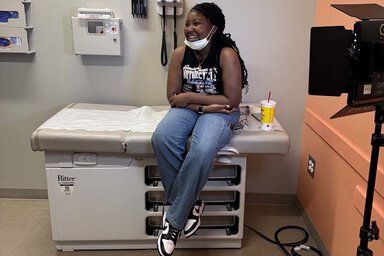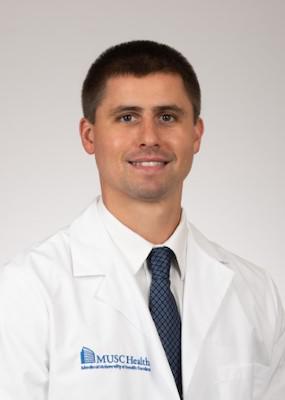
Physical Medicine & Rehabilitation
Helping you achieve a better, healthier life.
Whether you’re recovering from illness or injury, our Physical Medicine and Rehabilitation doctors and therapists are united in one goal: helping you achieve a better, healthier life.
We understand the profound effects that chronic pain and loss of function can have on your physical and emotional well-being. That’s why our approach is holistic and collaborative. Our team of dedicated specialists listens to you. We will conduct a complete assessment of your health and consult with your other medical specialists to create a personalized plan that addresses the complexities of your pain.
From sprains and strains to spinal pain, our PM&R service provides the latest evidence-based pain relief treatments for musculoskeletal chronic and nonchronic pain, including interventional procedures as well as pharmacological and outpatient rehabilitative therapy. We also offer nerve testing for specific conditions. Our procedures are performed under the care of physicians.
Our doctors are board-certified, fellowship-trained pain specialists who bring extensive experience and training in physical medicine and pain management strategies to patient care.
Conditions We Treat
- Non-operative spinal pain
- Joint and tendon disorders and injuries
- Low back or neck pain
- Degenerative disk disease
- Traumatic brain injury
- After effects of:
- Acquired brain injury
- Amputation
- Spinal cord injury
- Stroke
- Scoliosis
- Sports Injury
- Spinal stenosis
- Whiplash syndrome
- Sciatica
- Disc herniation
- Buttock pain
- Muscle spasms
- Arthritis-related pain
- Spasticity
Recent News & Stories



Expertise in a Wide Range of Treatments
Botulinum toxin injections for spasticity are a form of therapy used to reduce muscle spasms. The active ingredient in the injections is botulinum toxin, a natural protein produced by the bacterium Clostridium botulinum. Some brand names that patients might be familiar with include Botox, Myobloc, Xeomin, and Dysport. This toxin works by blocking nerve signals from the brain to the muscles, which helps to reduce muscle spasticity.
The injections can be used to treat a variety of conditions, including spasticity associated with brain injury, stroke, cerebral palsy, multiple sclerosis, and spinal cord injury. Botulinum toxin injections are usually administered in a series of injections into the affected muscles, and the effects typically last for three to six months. Side effects of the injections can include localized pain, swelling, and bruising.
Epidural steroid injections involve a mixture of numbing medication and a steroid injected at the spine's level with a disc herniation or other cause of nerve irritation. The injection can be done in the neck, thoracic area, or lower back. In the low back, people sometimes call this problem "sciatica." Epidural steroid injections are relatively safe, quick procedures and are good options to try before considering surgery for back pain. Although these injections provide temporary relief, they can be repeated.
Nerve blocks and pain injections are used to relieve pain in the back, as well as pain in the muscles, nerves, and joints in various parts of the body. They’re also used to identify and diagnose sources of pain. In some cases, a nerve block may be recommended if surgery is not an option.
Injections and nerve blocks are typically outpatient procedures with local anesthesia to ensure patient comfort. Typically, X-ray or ultrasound guidance is used to identify the precise location for the injection or nerve block.
Joint and tendon injections are used to relieve pain that might occur in the arms or legs, usually due to arthritis. They can also be used to identify the source of a patient’s pain. In some cases, a joint or tendon injection may be recommended if surgery is not an option.
Joint and tendon injections are typically outpatient procedures with local anesthesia to ensure patient comfort. Typically, ultrasound guidance is used to identify the precise location of the joint or tendon in question, but sometimes x-ray guidance is used.
Nerve conduction studies and electromyography are used to determine why a patient is experiencing pain, numbness, weakness, or tingling sensations. Based on the findings, our specialists then diagnose the nerve and muscle disorders and develop an effective treatment plan.
Tiny electrodes are inserted either into the muscle or placed on the skin. The electrodes send small electrical impulses that our specialists use to accurately diagnose the condition and customize a treatment plan.
Regenerative medicine refers to biologic treatments used to improve symptoms of certain orthopedic conditions that have the potential to enhance healing in musculoskeletal tissues. These procedures include prolotherapy, PRP injections, stem cell injections, and other procedures. The most common of these procedures that we perform are called platelet-rich plasma (PRP) injections. PRP is produced from a small sample of a person’s own blood. The blood is spun down to isolate and concentrate platelets, which assist in the natural tissue healing response. The PRP is then injected back into the patient at their injury site using ultrasound guidance. PRP has been used for many orthopedic injuries, including ligaments, tendons, cartilage, and muscle. PRP is generally safe as it is derived from the patient’s own blood.
When conservative pain management methods have failed to relieve chronic pain in the low back, leg, neck, or arm, a spinal cord stimulator may be recommended as an alternative to surgery.
The spinal cord stimulator works by blocking nerve pain signals that travel up the spinal cord to the brain. It is inserted beneath the skin in the back near the spinal cord and contains a battery similar to that of a pacemaker. The device emits electrical impulses to disrupt the nervous system’s natural impulses. The frequency, strength, and location of the stimulator’s electrical impulses can be precisely controlled through programming or handheld devices. An advantage of the stimulator is that it can be used temporarily on a trial basis before it is permanently implanted.
Find a Provider
MUSC Health has a doctor or provider for you. Search by location, keyword, or specialty.

Matthew Sherrier, MD
- Physical Medicine & Rehabilitation
- Orthopaedics - Sports Medicine
- Summerville, SC

Renee Rosati, DO
- Physical Medicine & Rehabilitation
- Mount Pleasant, SC
- Summerville, SC

Kirsten Dawson, PA-C
- Orthopaedics
- Physical Medicine & Rehabilitation
- Mount Pleasant, SC



